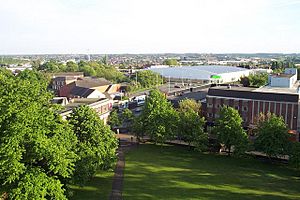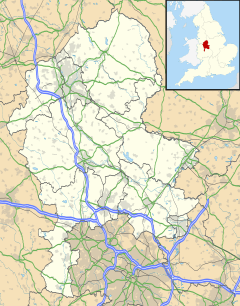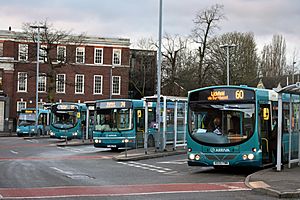Cannock facts for kids
Quick facts for kids Cannock |
|
|---|---|
 Cannock from top of St. Luke's Church Tower |
|
| Area | 9.24 km2 (3.57 sq mi) |
| Population | 29,018 (2011 Census) |
| • Density | 3,140/km2 (8,100/sq mi) |
| Demonym | Cannocker |
| OS grid reference | SJ980101 |
| District |
|
| Shire county | |
| Region | |
| Country | England |
| Sovereign state | United Kingdom |
| Post town | CANNOCK |
| Postcode district | WS11 |
| Dialling code | 01543 |
| Police | Staffordshire |
| Fire | Staffordshire |
| Ambulance | West Midlands |
| EU Parliament | West Midlands |
| UK Parliament |
|
Cannock (/ˈkænək/) is a town in the Cannock Chase area of Staffordshire, England. In 2011, about 29,018 people lived there.
Cannock is close to other towns like Walsall, Burntwood, Stafford, and Telford. The cities of Lichfield and Wolverhampton are also nearby. It sits north of the West Midlands conurbation and is connected by major roads like the M6, A34, and A5. To the south, you'll find Hednesford and the beautiful Cannock Chase Area of Outstanding Natural Beauty. Cannock also has its own train station on the Chase Line.
Contents
History of Cannock
Cannock was first mentioned in a very old book called the Domesday Book in 1086. Its name has changed over time, from "Chnoc" to "Canoc." The name probably comes from an old English word, cnocc, which means 'hillock' or small hill. This might refer to Shoal Hill, which is north-west of the town.
Cannock used to be a small farming community. But in the mid-to-late 1800s, coal mining grew a lot. Many industries moved to the area because it was near the Black Country and had plenty of coal. Cannock's population kept growing in the 1900s. Even after the last coal mine in Cannock closed in 1967, and the last one in the wider Cannock Chase area closed in 1993, the town continued to develop.
The total population of the built-up area around Cannock was 86,121 in 2011. This makes it the second largest built-up area in Staffordshire.
A historic house called The Green, built in the 1730s, became the main office for the local council in 1927. Later, it was turned into offices and then refurbished for private use.
Near Cannock, there is the Cannock Chase German war cemetery. This cemetery holds the graves of 4,885 German soldiers who died in the First and Second World Wars. The Commonwealth War Graves Commission takes care of it.
Geography and Climate
Cannock is located on a gentle slope. The land goes down from the highest point on Cannock Chase, called Castle Ring (244 meters high), to about 148 meters in the town centre. The soil is light, with gravel and clay underneath, and there are many coal deposits.
Weather in Cannock
Cannock has a mild climate, meaning it's not too hot or too cold. You can find details about average temperatures and rainfall from the Met Office weather station in Penkridge. Penkridge is about 5 miles (8 km) north-west of Cannock.
Where is Cannock?
Cannock is about 20 miles (32 km) north-north-west of Birmingham. It's also about 80 miles (129 km) south-south-east of Manchester and 130 miles (209 km) north-west of London.
Many nearby towns and cities are about 9 to 10 miles (14 to 16 km) away. These include Lichfield, Stafford, Walsall, and Wolverhampton. Closer towns are Hednesford (2 miles / 3 km), Burntwood (5 miles / 8 km), and Rugeley (7 miles / 11 km).
 |
Penkridge | Huntington, Stafford | Hednesford, Rugeley |  |
| Brewood, Shifnal, Telford, Gailey | Cannock Wood, Burntwood, Hammerwich, Heath Hayes, Lichfield | |||
| Featherstone, Wolverhampton | Great Wyrley, Cheslyn Hay, Landywood, Bloxwich, Willenhall, Walsall | Norton Canes, Brownhills, Aldridge |
People of Cannock
In the ten years leading up to 2011, the number of homes in Cannock grew by 7.8%. Most households were families, and many people owned their homes.
Most people in Cannock described their health as good or very good. The majority of residents are White British. A small percentage of people were born outside the United Kingdom.
News and Radio
Newspapers
Cannock used to have a free local newspaper called the Cannock & Rugeley Chronicle. It stopped printing in 2018 but you can still read it online. The Express & Star is another local newspaper that is published on weekdays.
TV and Radio
Local TV news for Cannock comes from BBC West Midlands and ITV Central. You can get TV signals from transmitters at Sutton Coldfield or The Wrekin.
Cannock also has its own local radio station called Cannock Chase Radio FM. You can listen to it on 94 FM in Cannock and Hednesford, and on other frequencies in nearby areas. You can also listen online.
Getting Around Cannock
Cannock is well-connected by major roads. It's close to the M6, M6 Toll, and M54 motorways. The main A roads are the A5 (running east-west) and the A34 (running north-south).
Trains
Cannock railway station closed in 1965 but reopened in 1989. It's part of a train line that connects Rugeley, Cannock, Walsall, and Birmingham. This line is operated by West Midlands Trains. More and more people have been using this train line over the years. In 2019, the railway line was updated to use electric trains.
Most trains from Cannock go north to Rugeley Trent Valley. Southbound trains go to Birmingham International and even London Euston. A train ride to Birmingham takes about 36 minutes. On Sundays, trains also go as far south as Coventry.
Buses
D&G Bus operates most of the bus services around Cannock under the Chaserider brand. National Express West Midlands also has a service, the X51, which connects Cannock with Birmingham.
Cannock Bus Station has connections to many nearby towns and villages. These include Hednesford, Rugeley, Stafford, Lichfield, Wolverhampton, Walsall, and Brownhills.
Schools in Cannock
Cannock has several schools for different age groups.
- Cannock Chase High School is a large school for students aged 11 to 18.
- Cardinal Griffin Catholic College is a Roman Catholic secondary school for students aged 11 to 18.
- Chase Grammar School is an independent school that also has a nursery. It teaches students up to age 19, including many international students.
South Staffordshire College used to have a campus in Cannock. It closed in 2017 but reopened in 2018 as the new Cannock Chase Skills and Innovation Hub, offering various courses.
Famous People from Cannock
Many interesting people have connections to Cannock!
Public Service
- Walter Colman (1600–1645) was a friar.
- Henry Sacheverell (1674–1724) was a clergyman and preacher.
- Frank Edward Tylecote (1879–1965) was a doctor and professor who studied the link between smoking and lung cancer.
- Vernon Rylands Parton (1897–1974) invented many different types of chess games.
- Jennie Lee (1904–1988) was a Member of Parliament for Cannock. She helped create the Open University.
- Raymond Furnell (1936–2006) was a curate in Cannock and later became the Dean of York.
- Bill Skitt (1941–2016) was a well-known British police officer.
- Sir Patrick McLoughlin (born 1957) is a politician who went to school in Cannock.
- Richard Davies (born 1959) is a doctor who worked in the Falklands and New Zealand.
Arts and Entertainment
- Arthur Hopcraft (1932–2004) was an author and TV writer who wrote about growing up in Cannock.
- Elgar Howarth (born 1935) is a conductor, composer, and trumpeter.
- Mel Galley (1948–2008) was a guitarist and songwriter for the band Whitesnake.
- Glenn Hughes (born 1952) was the bassist and singer for Deep Purple.
- Robert Lloyd (born 1959) is the lead singer for the band The Nightingales.
- Jed Mercurio (born 1966) is a British TV writer and producer who grew up in Cannock.
- Steve Edge (born 1972) is an English actor and writer.
- Balaam and the Angel is a rock band that started in Cannock in 1984.
- Chris Overton (born 1988) is an English actor and filmmaker.
- Daniel Hewitt (born 1988) is a journalist and broadcaster.
Sports Stars
- Alec Talbot (1902–1975) was a footballer who played for Aston Villa F.C..
- Tom Galley (1915–2000) was a footballer for Wolverhampton Wanderers F.C..
- Harry Kinsell (1921–2000) was a footballer for West Brom and West Ham.
- Gordon Lee (born 1934) is a former footballer and football manager.
- Malcolm Beard (born 1942) was a footballer for Birmingham City F.C..
- Jim Rhodes (1946–2015) was a professional golfer.
- Paul Cooper (born 1953) was a football goalkeeper for Ipswich Town.
- Geoff Palmer (born 1954) was a footballer for Wolves.
- Bobby Hosker (born 1955) was a professional footballer.
- Vernon Allatt (born 1959) was a professional footballer.
- Steve James (born 1961) is a former professional snooker player.
- Dave Norton (born 1965) was a professional footballer.
- Mick Gosling (born 1972) won the Britain's Strongest Man contest in 2005.
- Richard Gosling (born 1974) won the Britain's Strongest Man contest in 2003.
- Kevin Pietersen (born 1980) is a famous English cricketer who played for Cannock Cricket Club.
- Andy Bishop (born 1982) was a professional footballer.
- Kris Taylor (born 1984) was a professional footballer.
- Riley Parsons (born 2000) is a professional snooker player.
Twin Town
Cannock is connected to another town in Germany called Datteln. They are "twin towns," which means they have a special friendship and cultural exchange.
Images for kids
-
Sir Patrick McLoughlin, 2017
See also
 In Spanish: Cannock para niños
In Spanish: Cannock para niños







